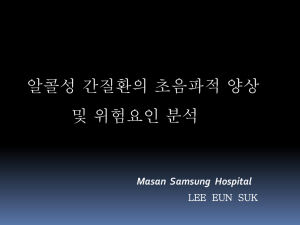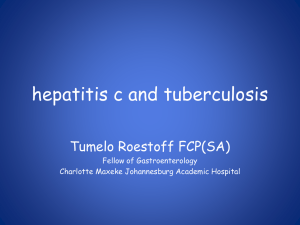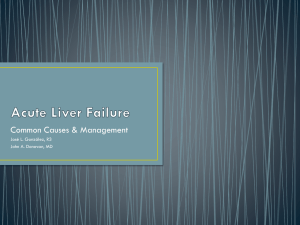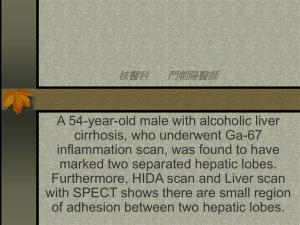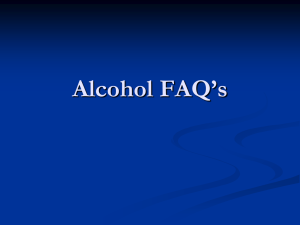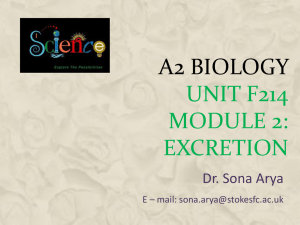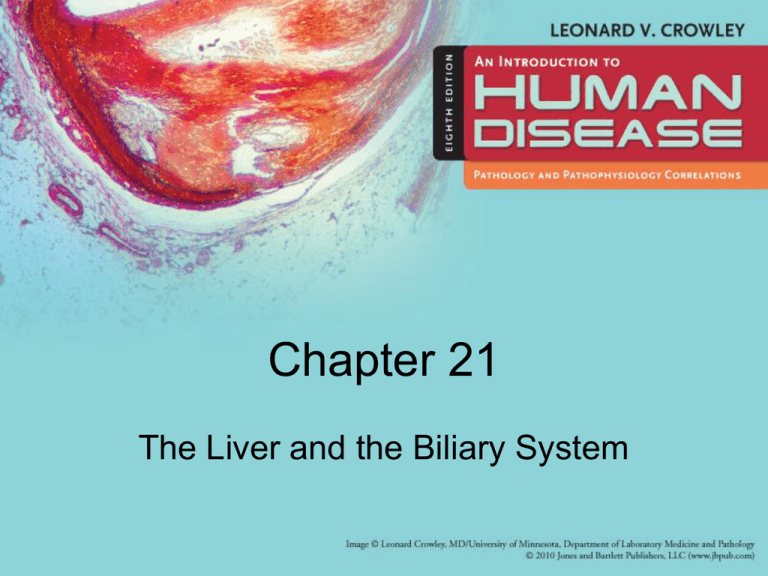
Chapter 21
The Liver and the Biliary System
Learning Objectives
• Describe normal structure and functions of the liver
in relation to the major diseases of the liver
• Describe causes of liver injury and the effects on
hepatic function
• Differentiate three major types of viral hepatitis
(pathogenesis, incubation period, incidence of
complications, frequency of carriers, diagnostic
tests)
• Explain adverse effects of alcohol intake on liver
structure, function
• Explain formation of gallstones, causes and effects
• Compare three major causes of jaundice
The Liver (1 of 2)
• Largest organ in body, right upper abdominal
area, beneath the diaphragm
• Main functions
– 1. Metabolism: carbohydrates, protein, and fat
delivered through the portal circulation
– 2. Synthesis: plasma proteins, clotting factors
– 3. Storage: vitamin B12 and other materials
– 4. Detoxification and excretion: various
substances
The Liver
The Liver (2 of 2)
• Has a double blood supply
– Portal vein: 75% of blood, drains spleen and GI tract,
rich in nutrients absorbed from intestines, low in oxygen
– Hepatic artery: rest of blood, high in oxygen, low in
nutrients
– Both blood mix in the liver eventually collecting into
right and left hepatic veins that drain into inferior vena
cava
• Portal triad, portal tracts travel together
–
–
–
–
Hepatic artery branches
Portal vein
Bile ducts
Lymphatic vessels
A CT scan of the upper abdomen illustrating
liver and upper abdominal organs.
Bile (1 of 2)
• From the breakdown of red blood cells
• When red blood cells break down, iron is reused
and iron-free heme pigment or bilirubin is
excreted in the bile
• Small quantities of bile are continually present in
blood
• When blood passes through liver, bilirubin is
removed by conjugation or by combining bilirubin
with glucuronic acid
• Bile: aqueous solution with various dissolved
substances
– 1. Conjugated bilirubin
– 2. Bile salts: major constituent of bile; derivatives of
cholesterol and amino acids; emulsify fat; function as
detergents
Bile (2 of 2)
• Other substances present in bile
–
–
–
–
Lecithin: lipid that also functions as a detergent
Cholesterol
Water
Minerals
• Bile is secreted continually
– Concentrated and stored in gallbladder
– During digestion, gallbladder contracts, releasing bile
into the duodenum
– Bile does not contain digestive enzymes, but acts as
a biologic detergent
Biliary Duct System
Types of Liver Injury
• Manifestations
– Cell necrosis
– Fatty change
– Mixed necrosis and fatty change
• Common types of liver injury
– Viral hepatitis
– Fatty liver
– Alcoholic liver disease or alcoholic hepatitis
– Cirrhosis
Liver Injury
© Courtesy of Leonard Crowley, M.D./University of Minnesota Medical School
Hepatitis A
•
•
•
•
RNA-containing virus
Incubation period: 2 to 6 weeks
Excreted through nose, throat, stools
Transmission
– Person-to-person contact
– Fecal contamination of food or water
• Self-limited; no carriers; no chronic liver disease
• Prevention
– Hepatitis A vaccine
– Hepatitis A immune globulin: given after exposure
Acute viral hepatitis
Hepatitis B
•
•
•
•
DNA-containing virus
Incubation period: 6 weeks to 4 months
Transmission: blood or body fluids
Diagnosis: antigen-antibody test results
– Infected persons: HBsAg positive; lack anti-HBs
– Immune persons: presence of anti-HBs
– 10% become carriers and may develop chronic liver
disease
• Prevention
– Hepatitis B vaccine
– Hepatitis B immune globulin: given after exposure
Electron photomicrographs of complete virus
particles (arrows) and excess surface antigen in
blood of patient with hepatitis B
Lancet 1:695-8. Used with permission.
Electron photomicrographs of complete virus particles
(arrows) and surface antigen in blood of patient with
hepatitis B.
Lancet 1:695-8. Used with permission.
Acute HBV Infection and recovery
Hepatitis C (1 of 2)
•
•
•
•
RNA virus
Incubation period: 3 to 12 weeks
Transmission: blood and body fluids
Antigen-antibody test results
– HCV RNA: presence of virus in blood and active
infection
– Anti-HCV: infection but does not confer immunity
• 75% become carriers and many develop chronic
liver disease
• No prevention of disease after exposure
• No immunization available
Hepatitis C (2 of 2)
• Testing for asymptomatic HCV infection
• Recommendations
– 1. Persons who have injected illegal drugs
– 2. Persons who received antihemophilic
globulin or other clotting factor concentrates
before 1987
– 3. Persons who received blood transfusions
before 1992
– 4. Health care personnel who have been
exposed to blood or body fluids
Hepatitis D: Delta Hepatitis
• Small, defective RNA virus
• Only infects persons with acute or
chronic HBV infection
• Delta virus is unable to produce its own
virus coat and uses HBsAg produced by
HBV
• Most U.S. cases from sharing needles
Hepatitis E
• RNA-containing virus
• Transmission
– Oral-fecal
– Contaminated water
• No prevention of disease after exposure
• No immunization available
Hepatitis Outcomes
Fatty Liver
•
•
•
•
Fat accumulates in liver secondary to injury
Common in heavy drinkers and alcoholics
May be caused by chemicals and solvents
Impaired liver function but injury is still
reversible
Fatty Liver
Alcoholic Liver Disease
• Refers to a group of structural and functional
changes in the liver resulting from excessive
alcohol consumption
• Severity depends on amount and duration of
alcohol consumption
• 3 stages of progression
– 1. Alcoholic fatty liver: mildest form
– 2. Alcoholic hepatitis: causes degenerative changes and
necrosis of liver cells
– 3. Alcoholic cirrhosis: most advanced, diffuse scarring,
disturbed liver function
A photomicrograph illustrating hepatic cellular
structure in alcoholic hepatitis. One necrotic cell is
surrounded by a cluster of neutrophils
A high-magnification photomicrograph of
Mallory body in swollen liver cell
Cirrhosis (1 of 3)
• Diffuse scarring of the liver from any cause with
derangement of liver function and regeneration
–
–
–
–
–
Alcoholic liver disease
Chronic hepatitis
Severe liver necrosis
Repeated liver injury: drugs and chemicals
Longstanding bile duct obstruction
• Manifestations
– Liver failure
– Portal hypertension
– Ascites, collateral circulation formation
Cirrhosis (2 of 3)
• Manifestations
– Bypass routes connect systemic-portal venous systems
– Anastomoses develop between branches of portal and
system veins
– Blood shunted away from high pressure portal system
into low pressure veins of systemic circulation
• Esophageal veins become distended
• Risk of fatal hemorrhage from esophageal varices
– Inability to inactivate estrogen in males
• Testicular atrophy, loss of sex drive, breast hypertrophy
Advanced hepatic cirrhosis illustrating elevated
nodules of liver tissue surrounded by depressed
areas of scar tissue. Exterior of liver.
A low-magnification photomicrograph of cirrhotic liver
illustrating nodules of liver cells circumscribed by
dense scar tissue (blue-green stain).
Mucosal surface of esophagus showing varices
Cirrhosis (3 of 3)
• Surgical procedures
– Portal-systemic anastomoses to control varices
• Splenorenal shunt
• Portacaval shunt
• Intrahepatic portosystemic shunt
– Transjugular intrahepatic portosystemic shunt (TIPS)
• An alternative to an open operative procedure
• Intrahepatic shunt between hepatic and portal vein branches
• Materials in ascitic fluid may cause intravascular
coagulation syndrome, other complications
Ascites
Surgical Procedures to Treat Cirrhosis
Surgical Procedures to Treat Cirrhosis
A comparison of normal blood flow
pathways with those in cirrhosis
Hepatic Encephalopathy
• Deterioration of brain function characterized by
impaired consciousness, confusion, disorientation,
and eventually coma
– From accumulation of toxic substances in the blood that
are normally detoxified and excreted by the liver
– Toxic products include ammonia from deamination of
amino acids and bacterial decomposition products of
colonic fecal material
• Precipitating events
– Conditions that reduce hepatic blood flow or liver cell
functions
Biliary Cirrhosis
• Primary biliary cirrhosis
– Autoimmune disease attacking small intrahepatic bile
ducts
– No specific treatment, may lead to liver failure
– Require liver transplant
• Secondary biliary cirrhosis
– Obstruction of large extrahepatic bile ducts
• Gallstone, carcinoma in pancreas, cancer from common bile
duct
– Treatment: relieve or bypass duct obstruction
Cholelithiasis (1 of 2)
• Formation of stones in the gallbladder
• Incidence
–
–
–
–
Higher in women than men
Higher in women who have borne several children
Twice as high in women who use contraceptive pills
Higher in obese women
• Factors influencing solubility of cholesterol in bile
– Cholesterol is insoluble in aqueous solution
– Dissolved in micelles composed of bile salts and
lecithin
– Solubility of cholesterol depends on ratio of cholesterol
to bile salts and lecithin
Cholelithiasis (2 of 2)
• Complications
– Asymptomatic
– Biliary colic if stone is extruded into ducts
• Common duct obstruction: obstructive jaundice
• Cystic duct obstruction: no jaundice, acute
cholecystitis may occur if with preexisting
infection in gallbladder
• Treatment
– Cholecystectomy
– Chenodeoxycholic acid dissolves
gallstones
Cholelithiasis
Cholecystitis
• Inflammation of gallbladder
– Chronic infection is common
– Gallstones may predispose to cholecystitis
– Impaction of a stone in neck of gallbladder
may cause acute cholecystitis
Cholecystitis
Reye Syndrome
• Pathogenesis
– Evidence suggests the combined effect of viral illness
and use of acetylsalicylic acid (aspirin)
– Aspirin may increase injurious effects of virus
– Liver damage
– Brain damage
• Characteristics
–
–
–
–
Affects infants and children
Fatty liver with liver dysfunction
Cerebral edema with neurologic dysfunction
No specific treatment
Liver Tumors
• Benign adenomas: uncommon, occur in women
taking contraceptive pills
• Primary carcinoma
– Uncommon in U.S. and Canada but common in Asia
and Africa due to high incidence HBV carriers
– HBV carriers have a high risk for develop liver disease
and primary liver carcinoma
• Metastatic carcinoma
– Common in developed countries
– Spread from primary sites such as GI tract, lung,
breast
– Tumor cells carried in the blood and delivered to the
liver via hepatic artery
Metastatic Carcinoma
Jaundice
• Yellow discoloration of skin and sclera from
accumulation of bile pigment in tissues and
body fluids
• Causes of accumulation
– Hemolytic jaundice: increased breakdown of
red cells
– Hepatocellular jaundice: liver injury impairing
conjugation of bilirubin
– Obstructive jaundice: bile duct obstructed by
tumor or stone impairing delivery of bile into
duodenum
Liver Biopsy
• Indications
– To determine cause of liver disease
– To evaluate extent of liver cell damage in
persons with chronic hepatitis
• Needle inserted through abdominal skin
directly into liver
• Biopsy specimen examined histologically
by pathologist
– Provides specific diagnosis
– Provides basis for treatment
Discussion (1 of 2)
• Individuals at risk for developing Hepatitis
C include the following EXCEPT:
– A. Intranasal cocaine users
– B. Health care personnel exposed to blood
and body fluids
– C. Intravenous drug users
– D. Children born to mothers who tested
positive for Hepatitis C
– E. Children’s day care personnel
Discussion (2 of 2)
• What groups of people are considered at
risk for hepatitis C?
• What is anicteric hepatitis?
• What is subclinical hepatitis?
• Chronic liver disease is a complication of
which types of viral hepatitis?
• What is the clinical significance of Mallory
bodies?





